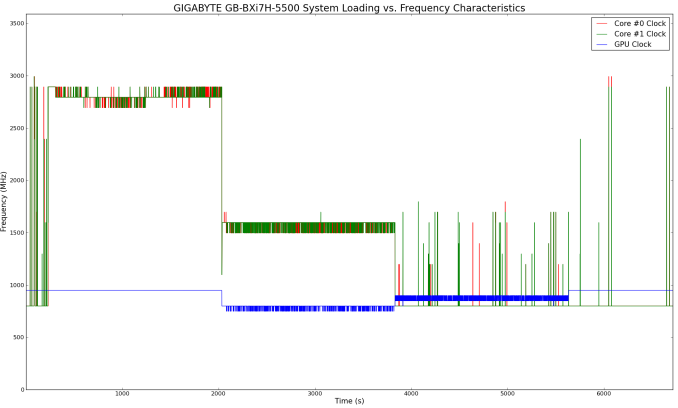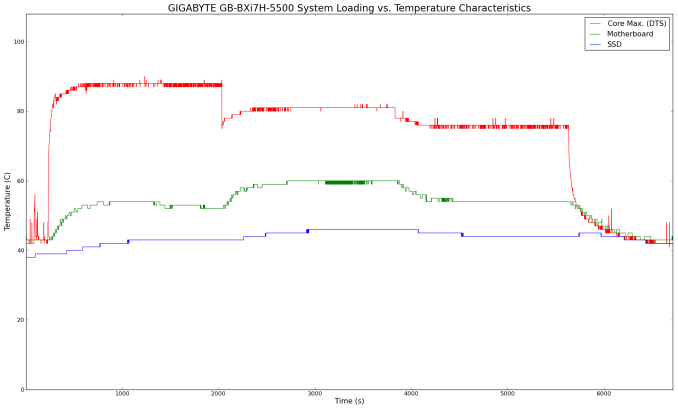GIGABYTE GB-BXi7H-5500 Broadwell BRIX Review
by Ganesh T S on January 29, 2015 7:00 AM ESTPower Consumption and Thermal Performance
The power consumption at the wall was measured with a 1080p display being driven through the HDMI port. In the graphs below, we compare the idle and load power of the GIGABYTE GB-BXi7H-5500 with other low power PCs evaluated before. For load power consumption, we ran Furmark 1.15.0 and Prime95 v28.5 together. The numbers are not beyond the realm of reason for the combination of hardware components in the machine.


The slightly higher base clocks in the Core i7-5500U (compared to the Core i7-4500U) are probably the reason for the Haswell-based unit appearing more power efficient than the Broadwell counterpart - but, make no mistake here - the Broadwell unit wins the performance per watt test quite easily.
The evaluation of the thermal performance was performed by monitoring the various clocks in the system as well as the temperatures with the unit when subject to the following workload. We start with the system at idle, followed by 30 minutes of pure CPU loading. This is followed by another 30 minutes of both CPU and GPU being loaded simultaneously. After this, the CPU load was removed, allowing the GPU to be loaded alone for another 30 minutes.
In the pure CPU loading scenario, the cpre frequencies stay well above the suggested base value of 2.4 GHz (indicating that GIGABYTE's trust in their cooling solution). The core temperature doesn't cross 90 C during this time (the junction temperature is 105 C). On the other hand, when the CPU and GPU are both loaded, the frequencies drop down to around 1.6 GHz for the cores. The GPU is advertised to run at a base clock of 300 MHz, with a turbo mode of 950 MHz. The actual frequency stays above 800 MHz comfortably throughout our stress test. In the absence of any CPU load, the cores drop down to 800 MHz. The temperatures are also below 80 C throughout the time that the GPU is loaded up.
All in all, the thermal solution is very effective. Given that the acoustic side-effects were not irksome (subjectively), we wonder if GIGABYTE has missed a trick by dialing down the overclocking and not allowing the full performance potential of the system to come through.












53 Comments
View All Comments
cobalt42 - Friday, January 30, 2015 - link
I think you're actually kind of agreeing -- as implied by the OP, 1366x768 is closer to 1280x720 than it is to 1280x1024. (768p is 80% of 12x10, 720p is 70% of 12x10). Either way, 1280x1048 is rather too many pixels.milkod2001 - Thursday, January 29, 2015 - link
This seems more reasonable build compared to ASrock a few days back you posted review about. But Im still not sold on temperatures it reaches. 90c is way too much. Looks like even Broodwell could not help. Problem must be the case, it's just way too small.My suggestion to vendors would be to completely ignore Intel's NUC standard build entirely and put everything into bigger aluminium case Apple mini like.
milkod2001 - Thursday, January 29, 2015 - link
in other words, clone Apple mini, make RAM + SSD upgradable and slap windows OS on that. Then we talk.nwrigley - Thursday, January 29, 2015 - link
I haven't seen anything that comes close to the Mac Mini on an engineering level. It's a real shame too, the Mac Mini has been out for 10 years and nothing has bested that design.I hope we start to see some more innovation. If you go a step above the Mac Mini in size/weight/performance you've probably doubled your size and weight (at least). I wish they would make parts for systems larger than a laptop, but smaller than a tower. I would gladly trade off some of the size and weight of the Mini for more performance.
Kalessian - Thursday, January 29, 2015 - link
This review hit my browser like a sack of brix. Thx.ericgl21 - Thursday, January 29, 2015 - link
This i7-5500U is not impressive at all.Even now with 14nm, a 15W CPU (with iGPU) from Intel still doesn't cut it.
Hopefully, Intel will release a proper quad-core CPU that would take on the i7-4770R in all respects, including a lower TDP.
BlueBlazer - Thursday, January 29, 2015 - link
Getting close and often surpassing AMD mobile APU offerings that has higher TDPs. Source of comparisons http://www.anandtech.com/show/8119/amd-launches-mo... and http://www.anandtech.com/show/7106/amds-a105750m-r... Although differrent resolutions, 1280x1024 has more pixels than 1366x768. Furthermore not forgetting that this Core i7 5500u is just a 15W part!Hulk - Thursday, January 29, 2015 - link
Not that I don't appreciate this fantastic review but are we going to see a Broadwell review?Specifically:
Broadwell, Haswell, Ivy, and Sandy with clocks normalized so we can see IPC improvements Work normalized so we can see a few generations of power efficiency improvements?
And finally head-to-head for each iGPU (with games and compute benches)?
TheinsanegamerN - Thursday, January 29, 2015 - link
Looks good. cant wait to pick up the hd 6000 varient. I may have missed it, but does the broadwell NUC allow for the TDP to be raised like the haswell ones did? that, combined with 2133 memory let hd 5000 stretch its legs and perform quite well. hd6000 would be even better.kgh00007 - Thursday, January 29, 2015 - link
Yeah I hope so! I have raised the TDP on my D54250WYK to 25W and also have 2133 RAM, makes a big difference in performance over 15W TDP and 1600 RAM in games!!